NAD T 973 User Manual
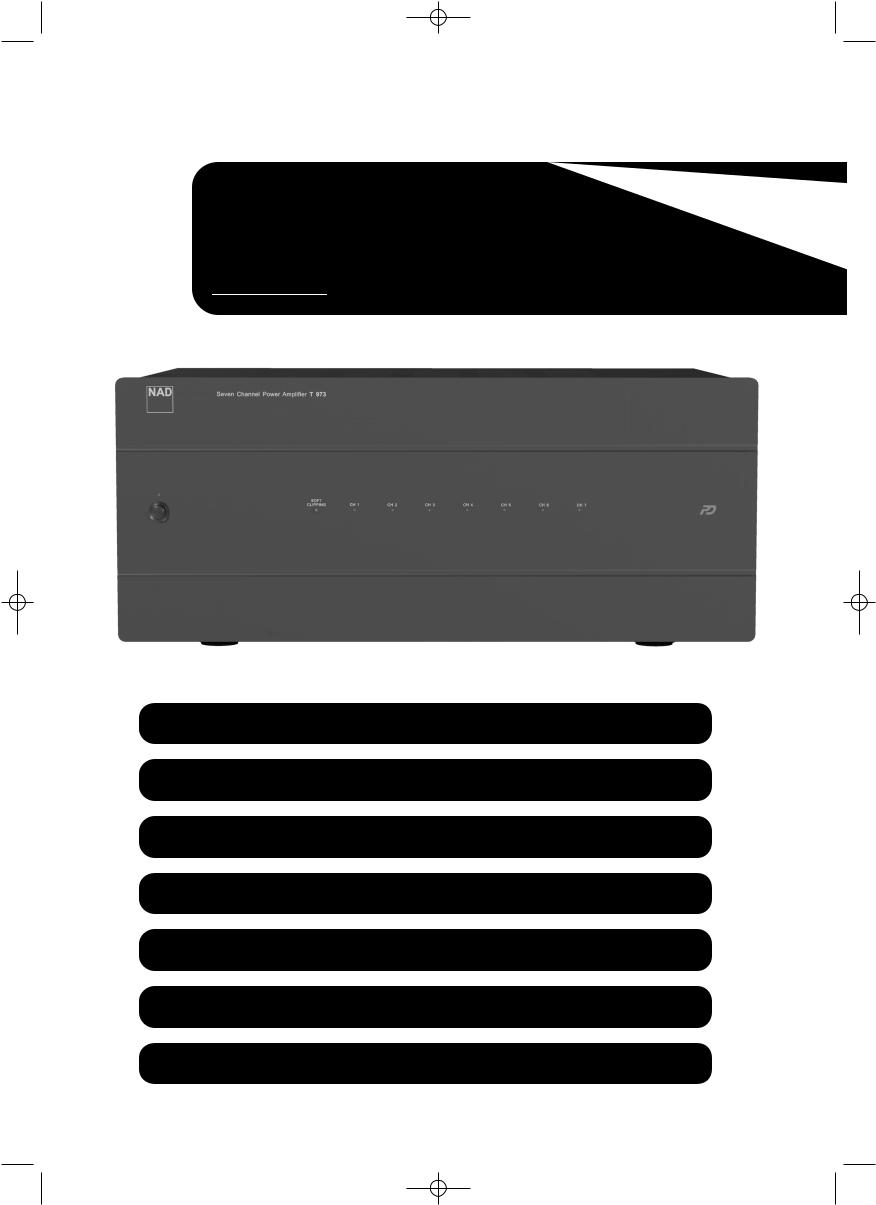
T 973manual C.qxd 8/21/2006 11:39 AM Page 1


 T 973
T 973
Seven Channel Power Amplifier
GB |
Owner’s Manual |
F |
|
Manuel d’Installation |
|
D |
|
Bedienungsanleitung |
|
E |
|
Manual del Usario |
|
I |
|
Manuale delle Istruzioni |
|
P |
|
Manual do Proprietário |
|
S |
|
Bruksanvisning |
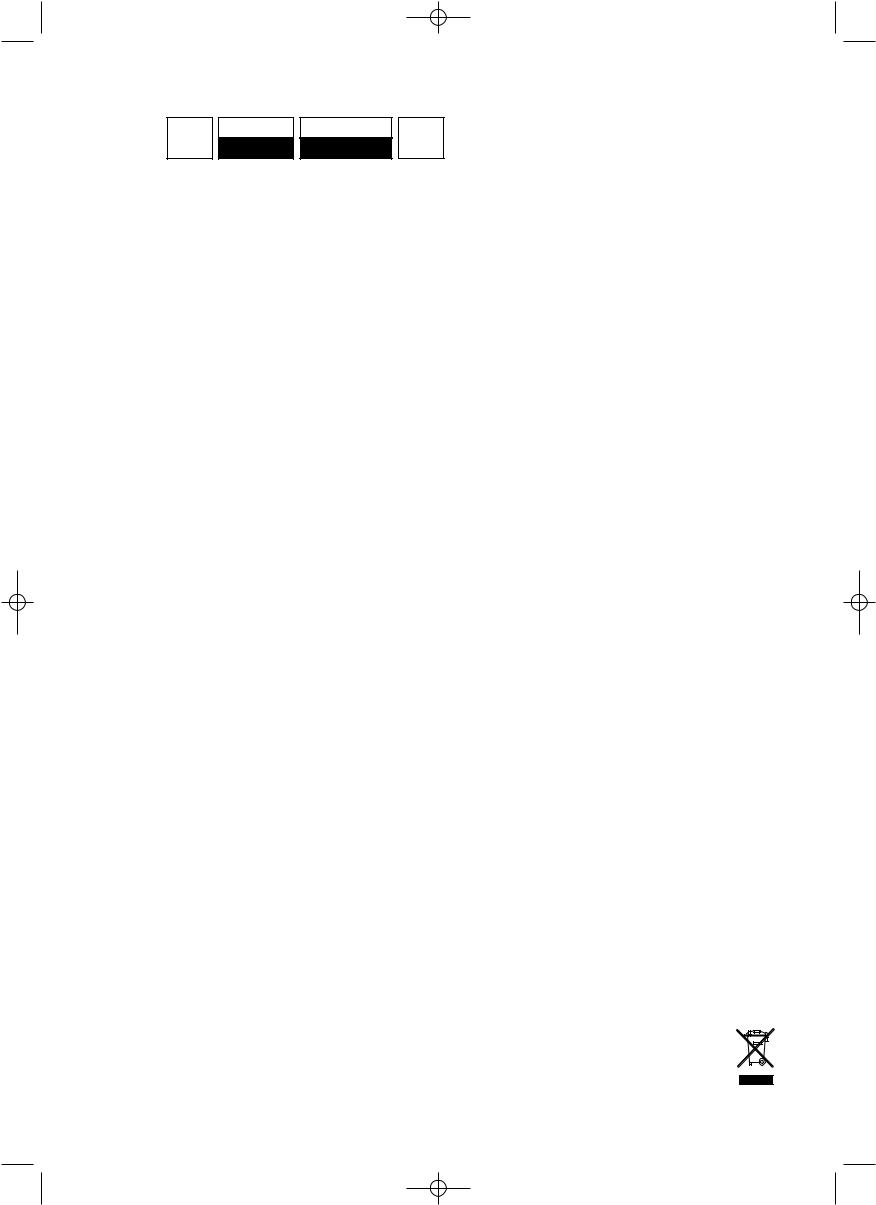
T 973manual C.qxd 8/21/2006 11:39 AM Page 2
IMPORTANT SAFETY INSTRUCTIONS
CAUTION |
ATTENTION: |
RISK OF ELECTRIC RISQUE DE CHOC ELECTRIQUE |
|
SHOCK DO NOT OPEN |
NE PAS OUVRIR |
CAUTION: TO REDUCE THE RISK OF ELECTRIC SHOCK, DO NOT REMOVE COVER (OR BACK). NO USER SERVICEABLE PARTS INSIDE. REFER SERVICING TO QUALIFIED SERVICE PERSONNEL.
Warning: To reduce the risk of fire or electric shock, do not expose this unit to rain or moisture.
The lightning flash with an arrowhead symbol within an equilateral triangle, is intended to alert the user to the presence of uninsulated “dangerous voltage” within the product’s enclosure that may be of sufficient magnitude to constitute a risk of electric shock to persons.
The exclamation point within an equilateral triangle is intended to alert the user to the presence of important operating and maintenance (servicing) instructions in the literature accompanying the product.
Do not place this unit on an unstable cart, stand or tripod, bracket or table. The unit may fall, causing serious injury to a child or adult and serious damage to the unit. Use only with a cart, stand, tripod, bracket or table recommended by the manufacturer or sold with the unit. Any mounting of the device on a wall or ceiling should follow the manufacturer’s instructions and should use a mounting accessory recommended by the manufacturer.
An appliance and cart combination should be moved with care. Quick stops, excessive force and uneven surfaces may cause the appliance and cart combination to overturn.
Read and follow all the safety and operating instructions before connecting or using this unit. Retain this notice and the owner’s manual for future reference.
All warnings on the unit and in its operating instructions should be adhered to.
Do not use this unit near water; for example, near a bath tub, washbowl, kitchen sink, laundry tub, in a wet basement or near a swimming pool.
The unit should be installed so that its location or position does not interfere with its proper ventilation. For example, it should not be situated on a bed, sofa, rug or similar surface that may block the ventilation openings; or placed in a built-in installation, such as a bookcase or cabinet, that may impede the flow of air through its ventilation openings.
The unit should be situated from heat sources such as radiators, heat registers, stoves or other devices (including amplifiers) that produce heat.
The unit should be connected to a power supply outlet only of the voltage and frequency marked on its rear panel.
The power supply cord should be routed so that it is not likely to be walked on or pinched, especially near the plug, convenience receptacles, or where the cord exits from the unit.
Unplug the unit from the wall outlet before cleaning. Never use benzine, thinner or other solvents for cleaning. Use only a soft damp cloth.
The power supply cord of the unit should be unplugged from the wall outlet when it is to be unused for a long period of time.
Care should be taken so that objects do not fall, and liquids are not spilled into the enclosure through any openings.
This unit should be serviced by qualified service personnel when:
A.The power cord or the plug has been damaged; or
B.Objects have fallen, or liquid has been spilled into the unit; or
C.The unit has been exposed to rain or liquids of any kind; or
D.The unit does not appear to operate normally or exhibits a marked change in performance; or
E.The device has been dropped or the enclosure damaged.
DO NOT ATTEMPT SERVICING OF THIS UNIT YOURSELF. REFER SERVICING TO QUALIFIED SERVICE PERSONNEL
Upon completion of any servicing or repairs, request the service shop’s assurance that only Factory Authorized Replacement Parts with the same characteristics as the original parts have been used, and that the routine safety checks have been performed to guarantee that the equipment is in safe operating condition. REPLACEMENT WITH UNAUTHORIZED PARTS MAY RESULT IN FIRE, ELECTRIC SHOCK OR OTHER HAZARDS.
ATTENTION
POUR ÉVITER LES CHOC ELECTRIQUES, INTRODUIRE LA LAME LA PLUS LARGE DE LA FICHE DANS LA BORNE CORRESPONDANTE DE LA PRISE ET POUSSER JUSQU’AU FOND.
CAUTION
TO PREVENT ELECTRIC SHOCK, MATCH WIDE BLADE OF PLUG TO WIDE SLOT FULLY INSERT.
If an indoor antenna is used (either built into the set or installed separately), never allow any part of the antenna to touch the metal parts of other electrical appliances such as a lamp, TV set etc.
CAUTION
POWER LINES
Any outdoor antenna must be located away from all power lines.
OUTDOOR ANTENNA GROUNDING
If an outside antenna is connected to your tuner or tunerpreamplifier, be sure the antenna system is grounded so as to provide some protection against voltage surges and built-up static charges. Article 810 of the National Electrical Code, ANSI/NFPA No. 70-1984, provides information with respect to proper grounding of the mast and supporting structure, grounding of the lead-in wire to an antenna discharge unit, size of grounding conductors, location of antenna discharge unit, connection to grounding electrodes and requirements for the grounding electrode.
a.Use No. 10 AWG (5.3mm2) copper, No. 8 AWG (8.4mm2) aluminium, No. 17 AWG (1.0mm2) copper-clad steel or bronze wire, or larger, as a ground wire.
b.Secure antenna lead-in and ground wires to house with stand-off insulators spaced from 4-6 feet (1.22 - 1.83 m) apart.
c.Mount antenna discharge unit as close as possible to where leadin enters house.
d.Use jumper wire not smaller than No.6 AWG (13.3mm2) copper, or the equivalent, when a separate antenna-grounding electrode is used. see NEC Section 810-21 (j).
EXAMPLE OF ANTENNA GROUNDING AS PER NATIONAL ELECTRICAL CODE INSTRUCTIONS CONTAINED IN ARTICLE 810 - RADIO AND TELEVISION EQUIPMENT.
NOTE TO CATV SYSTEM INSTALLER: This reminder is provided to call the CATV system installer’s attention to Article 820-40 of the National Electrical Code that provides guidelines for proper grounding and, in particular, specifies that the ground cable ground shall be connected to the grounding system of the building, as close to the point of cable entry as practical.
NOTES ON ENVIRONMENTAL PROTECTION
At the end of its useful life, this product must not be disposed of with regular household waste but must be returned to a collection point for the recycling of electrical and electronic equipment. The symbol on the product, user's manual and packaging, point this out.
The materials can be reused in accordance with their markings. Through re-use, recycling of raw materials, or other
forms of recycling of old products, you are making an important contribution to the protection of our environment.
Your local administrative office can advise you of the responsible waste disposal point.
2
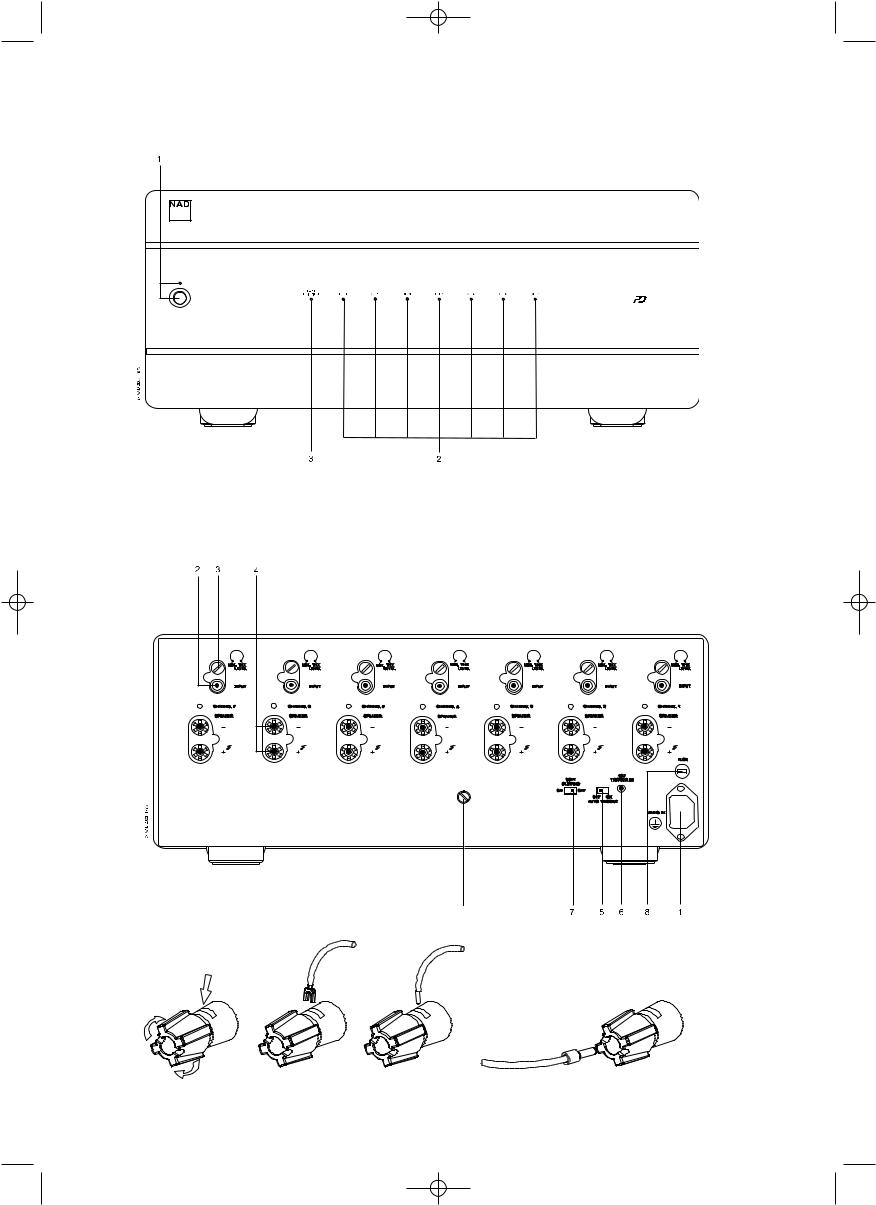
T 973manual C.qxd 8/21/2006 11:39 AM Page 3
FRONT PANEL CONTROLS
Seven Channel Power Amplifier T 973
REAR PANEL CONNECTIONS
GROUND
9
FIGURE 1
Spade |
Wire |
Pin |
3

T 973manual C.qxd 8/21/2006 11:39 AM Page 4
NAD T 973 Seven Channel Power Amplifier
ABOUT THE T 973
Designed specifically for home theater and custom installation setups, the NAD T 973 Power Amplifier delivers uncompromising performance. It combines supreme reliability, flexibility, and performance with outstanding value. Flexibility has always been an important part of NAD components. Such flexibility is particularly important in home theater and other multi-channel systems. That’s because it is common for a multi-channel system to incorporate different brands and models of loudspeakers. Often these speakers have different levels of efficiency. The individual input level controls for the seven channels of the NAD T 973 make it easy to compensate for such differences in efficiency, and achieve the ideal system balance. Ample dynamic headroom of the T 973 ensures that the very wide dynamic range of modern cinema soundtracks and digital music sources will be preserved. In addition, the T 973 will handle low impedance speakers with ease.
The T 973 incorporates NAD’s unique Soft-Clipping circuitry in all seven channels. Any amplifier can be overdriven if it is played too loud, exceeding the maximum output power. Under such circumstances, amplifiers produce extreme high levels of distortion which, besides sounding very unpleasant, can damage your loudspeakers. The Soft Clipping circuit suppresses such distortion and minimizes the risk of damage to speakers. This is particularly important with movie soundtracks which often contain very dynamic outbursts in which, unlike music, it is difficult to hear this potentially damaging distortion. The Soft Clipping LED on the front panel illuminates when the Soft Clipping circuit is engaged. Soft Clipping can be defeated with a rear panel switch.
The 12V trigger connection on the back panel allows the amplifier to be switched from On to Stand-by and vice-versa remotely. This way, the T 973 can be part of a system which can be turned on and off with a single command, easing operation. The 12V trigger also
GB |
allows the amplifier to be installed in places not in easy reach. |
|
|
|
THE DESIGN |
|
The NAD T 973 houses seven individual amplifiers, each on separate |
|
circuit board. Each amplifier channel acts as a “mono block” within |
|
the chassis. Each input connector, and set of loudspeaker output |
|
terminals, is directly connected to that channel’s circuit board. This |
|
design eliminates extra wiring and keeps signal paths short. |
|
Furthermore, this modular design increases reliability and thermal |
|
efficiency. The input circuit uses a totally new dual differential input |
|
topology that operates in true Class-A mode. The special |
|
Holmgren™ toroidal transformer has less hum and magnetic leakage |
|
than conventional toroidal transformers, but retains the usual |
|
benefits of high efficiency and high power-to-weight ratio. |
|
Ruggedness and reliability are critical in custom-installed systems. The |
|
T 973 uses a combination of fuses and non-intrusive electronic |
|
protection. This provides highly effective protection that does not |
|
effect audio performance. Each channel is protected against excess |
|
temperature, DC fault and loudspeaker short-circuit. The T 973’s |
|
inherently conservative, high-voltage/high-current output stage has |
|
been designed for years of trouble-free service. |
POWERDRIVE
To meet the diverse requirements of high current drive and high dynamic power, our patented PowerDrive amplifier circuit will build further on our reputation for amazingly effective power. By adding a second high-voltage rail to our well regulated high-current power supply, we get an "overdrive" that can nearly double the continuous power on a short term dynamic power basis. This is a further development and refinement of our renowned Power Envelope circuit, utilized by NAD in the 80's and 90's. PowerDrive differs from Power Envelope in that it offers greater amplifier stability and low impedance drive capability, resulting in less distortion when driving real speakers with real program material
INSTALLATION PRECAUTIONS
WARNING - To reduce the risk of fire or electrical shock, do not expose the amplifier to rain or moisture.
CAUTION - For units factory-set at 115 volts AC match the wide blade of the power plug to the wide slot of the power outlet, to prevent electrical shock. Be sure the plug is completely inserted into the receptacle.
Turn off all the components in the system whenever connecting or disconnecting any audio signal wiring. Once all signal connections have been completed, turn down all the system’s main volume control before turning the system components on. Then increase the volume control setting carefully to avoid damage to the system components.
NOTES ON INSTALLATION LOCATION
Read and follow all the safety instructions on the first page of this manual. To prevent a fire or shock hazard, do not place the amplifier where it will be exposed to any water or moisture. If liquid accidentally gets into the amplifier, immediately unplug the AC power cord. Do not operate the amplifier again until it has been examined by a service technician.
The amplifier generates a moderate amount of heat, requiring ventilation. Do not obstruct the air outlet grilles on the top or bottom covers. There should be at least 3 inches (7.5 cm) of clearance above the amplifier and 1 inch (2.5 cm) to the sides. Do not place the amplifier in an enclosed area, such as in a bookcase or in a cabinet, unless it is very well ventilated. Be sure there is adequate room behind the amplifier for signal input and speaker output connections. If you want to locate the amplifier on a carpeted floor, place a board under it in order to prevent it from sinking into the carpet, blocking the air inlets on the bottom. Do not place the amplifier where it will be exposed to direct sun light for prolonged periods of time.
This unit may be installed on any sturdy, level surface.
NOTE: The amplifier’s weight must always rest on its bottom feet. Never put the amp down on its rear panel, with its front panel facing up. Doing so risks damage to the input/output connectors.
The power transformer in the T 973 generates a magnetic hum field of moderate strength. Turntables (especially those with a moving-coil pickup cartridge) should not be located near the amplifier. Magnetic media, such as audio or video tapes and computer diskettes, should not be stored near the amplifier.
4
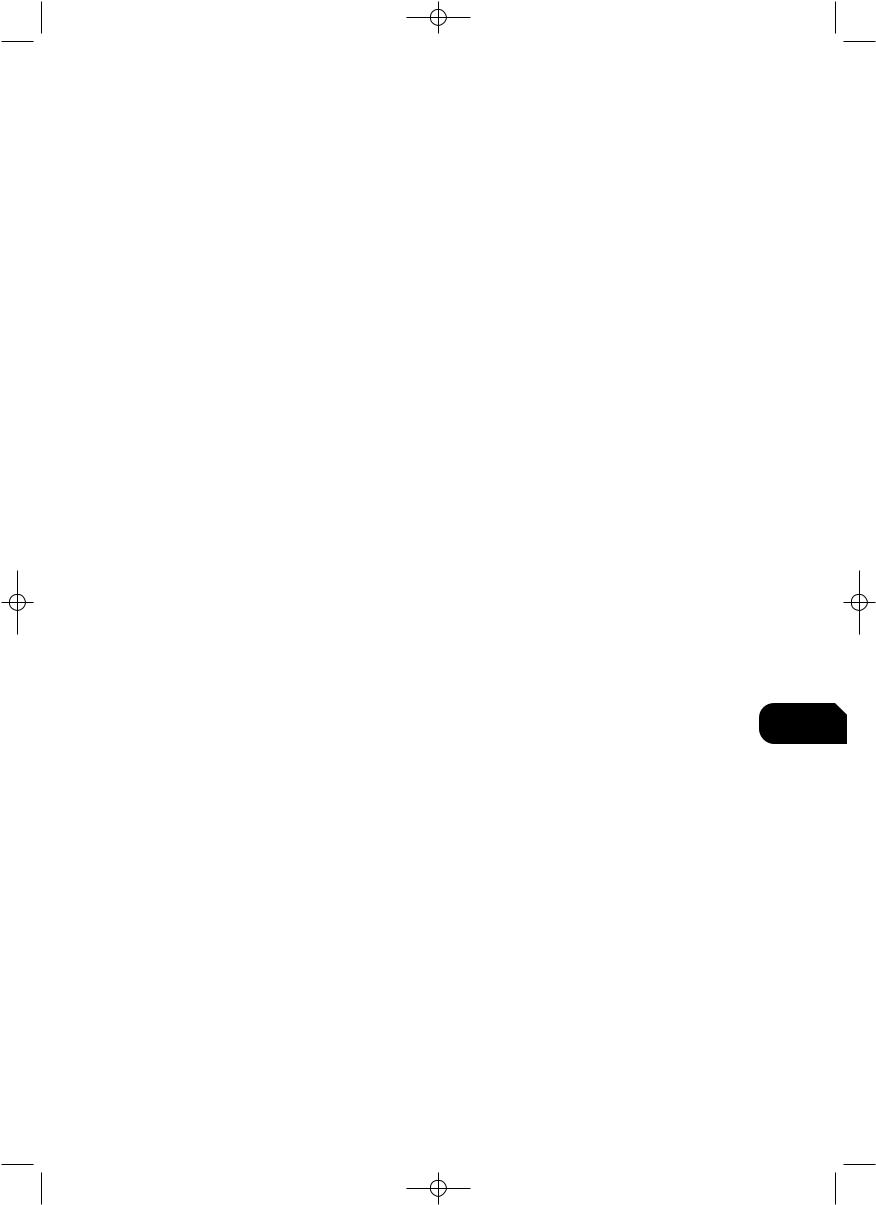
T 973manual C.qxd 8/21/2006 11:39 AM Page 5
REAR PANEL CONNECTIONS/CONTROLS
1. AC LINE CORD
Plug the AC line cord into a nearby wall outlet that provides the correct AC power line voltage, as indicated on the back panel of the unit. Do not plug the amplifier into a convenience outlet on your preamp. The amplifier requires more power than these outlets typically can provide.
2. INPUTS
Each of the seven independent power amplifiers within the T 973 has its own signal input connector. Before making any connections to the amplifier, make sure the POWER is switched OFF.
Connect the signal cables from the preamplifier, surround sound decoder, or other signal source to these inputs. For optimum heat dissipation in an AV surround system, we recommend you allocate the audio channels to the inputs as follows:
Input 1 = Right Main speaker
Input 2 = Right surround speaker
Input 3 = Center speaker
Input 4 = Left Surround speaker
Input 5 = Left Main speaker
Input 6 = Left Surround Rear speaker
Input 7 = Right Surround Rear speaker
3. INPUT LEVEL CONTROLS
The amplifier is equipped with separate input level controls for each channel. Before turning on the T 973 for the first time, make sure all level controls are in their normal full-clockwise position.
Under some circumstances, other settings may be useful for:
•Level-matching - In systems that incorporate speakers of varying efficiencies, it may be necessary to reduce the settings of some controls to achieve proper channel-to-channel balance.
•Extended volume-control range - Many stereo systems have so much voltage gain that the speakers (or your ears) are over-driven at any volume-control setting higher than 11 or 12 o’clock position of the volume control. As a result you can use only the lower half of the volume control’s range, where adjustments are imprecise and channel-balance errors tend to be greater. If all input level controls are reduced, you can turn up your preamplifier’s volume control, making effective use of most of its range. (Suggestion: Adjust the input level controls so that your preferred maximum sound levels occur at about 2 or 3 o’clock on the volume control.) As an added benefit, this procedure suppresses any noise produced by the preamp’s high-level circuitry (e.g. any residual hum or hiss that does not go away when the Volume is turned down).
4. SPEAKER CONNECTIONS
This amplifier is equipped with special high-current binding-post speaker terminals. Connect the loudspeakers with heavy-duty (16gauge or thicker) braided wire. Connections may be made in any of three ways. [See Figure 1.]
•Strip off a half-inch (1 cm) of insulation from each speaker wire. In each conductor, twist the thin strands of wire together. Unscrew the knob, insert the bare wire into the opening at the base of the binding post, and tighten the knob until it grasps the wire securely. Check to be sure that there are no loose strands of
wire touching the chassis or an adjacent terminal.
•Spade lugs. Unscrew the knob, insert the U-shaped spade lug behind the bushing, and tighten the knob until the spade lug is secured.
•Install banana plugs on your speaker wires, and plug them into the end of each binding post. The terminals are separated by 3/4 inch (l9mm), so they will accept dual-banana plugs (this option is not available on units with 230V line voltage factory setting).
NOTE: Speakers must operate in phase with each other in order to produce a proper stereo image and to reinforce rather than cancel each other’s output at low frequencies. When connecting speakers, take care that the red (positive) terminal on each loudspeaker is connected to the corresponding terminal marked red (positive) on the amplifier.
5. AUTO TRIGGER ON/OFF
Set the Auto Trigger switch to the On position to activate the 12Vtrigger. By connecting the 12V-trigger, the T 973 can be remotely switched to On and Stand-by and vice-versa. When set to the Off position, the 12V-trigger input is not active.
NOTE: With the Auto Trigger switch set to the ON position and the 12V-trigger input connected, the T 973 will switch from Off to Stand-by when the Power Switch on the front panel is pressed. For normal operation, ensure the switch is in the OFF position or that the 12V-trigger input socket is not connected.
6. 12V-TRIGGER INPUT
For external Power on/Stand-by switching, connect the 12V-trigger output of a source component to this DC input jack. The center pin is the live or + connection, the outer sleeve of the input jack is the 12V-trigger - or ground connection.
NOTES: The T 973’s 12V-trigger will work within a range of 6 to 15 V DC level and typically draws less than 10mA of current. Check the specifications of the 12V-trigger source to ensure it is compatible
with the T 973’s 12V-trigger input. Do not exceed the recommended GB voltage as this may cause damage to the T 973.
7. SOFT CLIPPING
When an amplifier is driven beyond its specified power output it normally produces “hard clipping” or distortion of the signal. Such hard clipping, in addition to sounding unpleasant, can damage the speakers in the system. The NAD Soft Clipping circuit gently limits the output waveform, minimizing audible distortion and reducing the change of speaker damage when the amplifier is overdriven. We recommend that the Soft Clipping switch on the back panel of the T 973 be left in the ON position when system is being operated at levels that might exceed the amplifier’s power capacity. The LED on the front panel indicates if Soft Clipping has been engaged.
8. FUSE HOLDER
There is a fuse holder nearby or next to the AC-line cord. In the unlikely event a fuse may need to be replaced, unplug the line cord form the wall. Then remove all connections from the amplifier. Only replace the fuse with the same type, size, and specification.
5
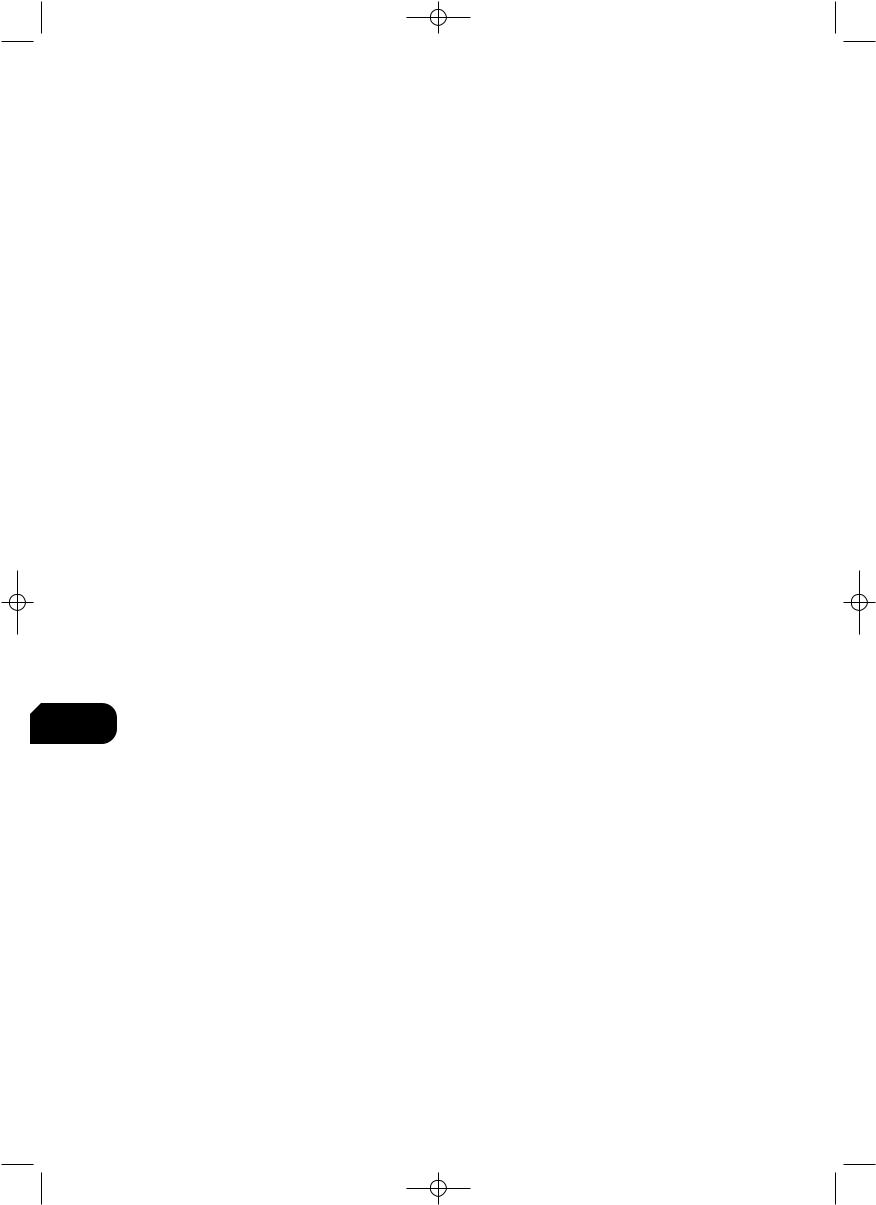
T 973manual C.qxd 8/21/2006 11:39 AM Page 6
|
9. GROUND CONNECTOR |
|
The T 973 is provided with a GROUND terminal on the rear panel. |
|
This terminal is connected directly to the chassis of the T 973. In |
|
the event of radio hum or radio interference, this terminal can be |
|
connected to a ‘true earth’ such as a copper plated rod driven |
|
several feet into the ground. |
|
FRONT PANEL CONTROLS |
|
1. POWER SWITCH/STAND-BY LED |
|
Press this button to switch the amplifier on or off. The Power LED |
|
located just above the power button and Protection LED will light up. |
|
After a few seconds, the Protection LED (2) will turn green, indicating |
|
that the amplifier is ready for use. |
|
The T 973 can also be remotely switched from On to Stand-by and |
|
vice-versa using the 12V-trigger input on the back panel. For the |
|
12V-trigger input to work, the T 973 must first be turned on by |
|
means of the Power switch, and the switch must be left in this |
|
position. Using the 12V-trigger source component, switch its 12V- |
|
trigger output to on and off. The T 973’s trigger input will now |
|
follow the source component’s 12V-trigger output. Ensure that the |
|
Auto Trigger switch on the back panel is in the ON position and that |
|
the 12V-trigger input is connected properly. |
|
2. PROTECTION LED |
|
The Protection LED will light up every time the amplifier is switched |
|
on. After a few seconds it will turn green and the amplifier is ready |
|
for operation. |
|
These LEDs will also come on when one or more of the internal |
|
seven amplifiers go into protect mode, but the other amplifiers will |
|
continue to function so it is likely you will still hear sound. |
|
When the amplifier is switched off completely from normal operation |
|
by means of the power switch, the Protection LEDs will light up and |
GB |
will fade out in a couple of seconds. |
NOTE: If you see the Protection LED light up during use, turn off the |
|
|
amplifier immediately. Check if all speaker wires are connected |
|
correctly and that none of the wires are damaged, causing a short |
|
circuit. Another cause may be excessive heat build-up inside the |
|
amplifier. Make sure there is adequate ventilation around the |
|
amplifier and that none of its ventilation slots, top or bottom, are |
|
blocked. After the amplifier has cooled down, it will function |
|
normally again. |
|
In case the Protection LED remains on despite the checks mentioned |
|
above, turn the amplifier off and consult your NAD dealer. |
|
3. SOFT CLIPPING LIGHTS |
|
When the Soft Clipping circuit of the T 973 is activated the indicator |
|
LED’s on the front panel will light. |
6
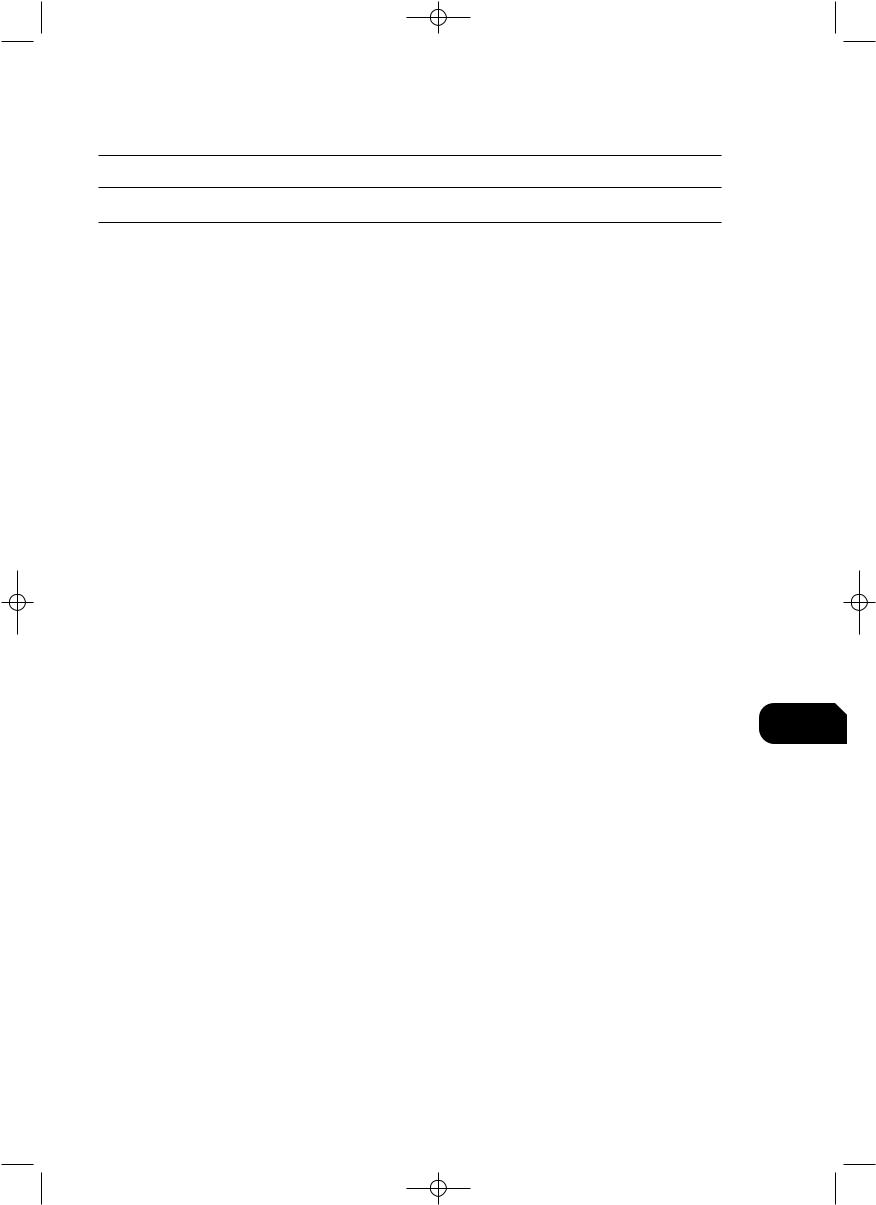
T 973manual C.qxd 8/21/2006 11:39 AM Page 7
TROUBLESHOOTING
PROBLEM |
CAUSE |
SOLUTION |
NO SOUND |
• Power AC lead unplugged or power not |
|
switched on |
•Check if AC lead is plugged in and power switched on
NO SOUND ON ONE CHANNEL |
• |
Speaker not properly connected or damaged. |
• Check connections and speakers |
|
• Input lead disconnected or damaged |
• Check leads and connections |
|
|
|
|
|
NO SOUND ON SURROUND CHANNELS |
• |
No surround mode selected |
• Select a Surround Mode |
|
• |
Mono sound source |
• Test system with Stereo or Dolby Surround |
|
• Speakers not properly connected |
material |
|
|
• Check speakers and connections |
||
|
• Surround volume level too low |
• Increase surround volume level |
|
|
|
|
|
NO SOUND ON CENTER CHANNEL |
• |
Speaker not connected properly |
• Check speaker and connection |
|
• Center volume level set too low |
• Increase center volume level |
|
|
|
|
|
WEAK BASS/ DIFFUSE STEREO IMAGE |
• |
Speakers wired out of phase |
• Check connections to all speakers in the system |
|
|
|
|
TEMPORARILY SWITCHES TO STANDBY, THEN |
• |
Amplifier is running too hot |
• Let the amplifier cool down |
SWITCHES BACK ON AUTOMATICALLY |
|
|
• Remove the excessive load condition |
|
|
|
• Speakers must be greater than 4 Ohms nominal |
|
|
|
|
GB
7
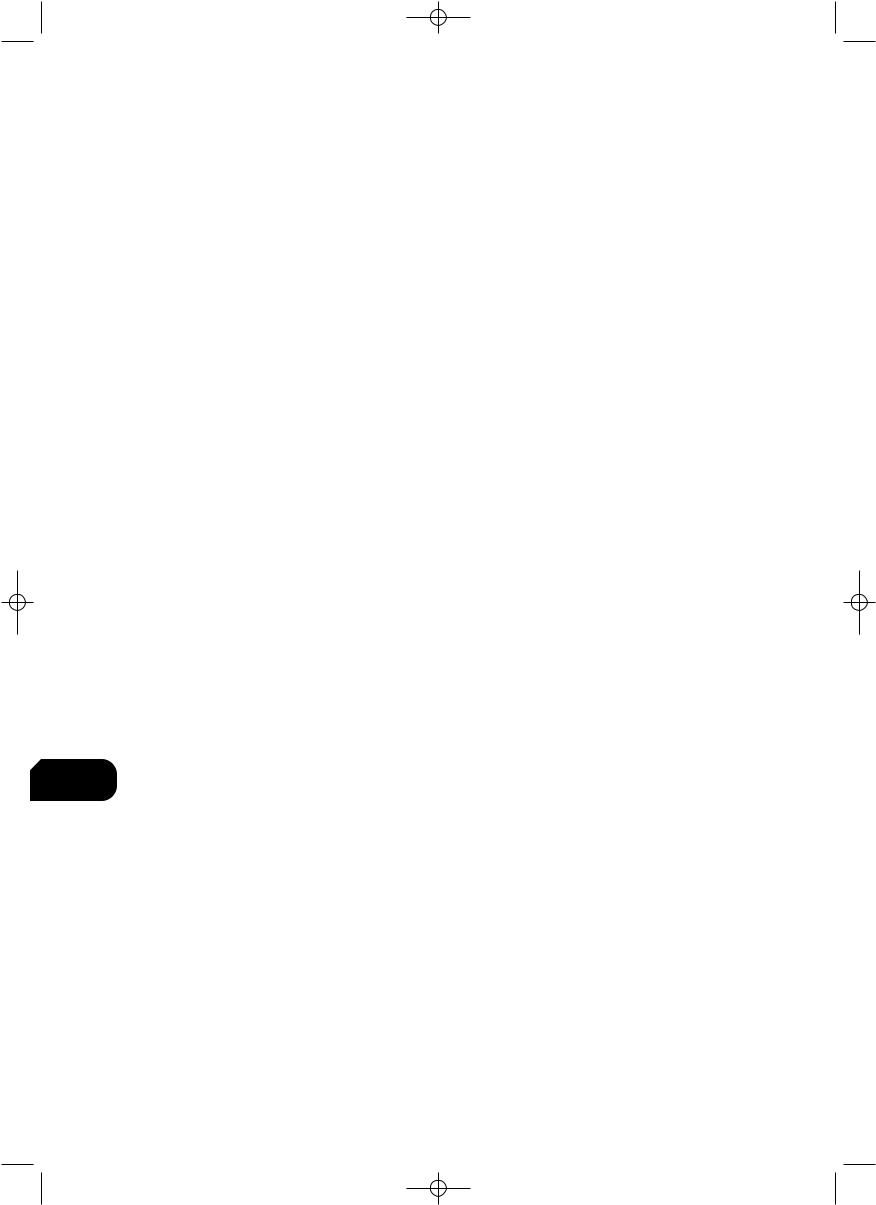
T 973manual C.qxd 8/21/2006 11:39 AM Page 8
NAD T 973 Amplificateur De Puissance Sept Voies
A PROPOS DU T 973
Conçu spécifiquement pour le cinéma à domicile et pour les configurations personnalisées, l’Amplificateur de Puissance NAD T 973 donne des performances hors pair. Il conjugue une fiabilité exceptionnelle avec une souplesse et des performances, le tout pour un rapport qualité-prix remarquable. La souplesse a toujours tenu une place importante dans la conception des éléments NAD. Une telle souplesse est particulièrement importante pour le cinéma à domicile et pour les autres chaînes multi-voies. Il est en effet courant qu’une chaîne multi-voies comporte des haut-parleurs de marques et de modèles différents, et le rendement de ces haut-parleurs est souvent inégal. Les commandes individuelles du niveau d’entrée de chacune des sept voies du NAD T 973 font qu’il est facile de compenser de telles différences de rendement et d’atteindre un équilibre idéal pour la chaîne. Le plafond dynamique très élevé du T 973 garantit que la plage dynamique très large des pistes sonores de films modernes sera respectée, tout comme celle des sources de musique numériques. De plus, le T 973 accepte les haut-parleurs à basse impédance sans aucune difficulté.
Le T 973 est doté des circuits uniques d’écrêtage doux de NAD sur les sept voies. Il est possible de surcharger n’importe quel amplificateur en poussant le volume sonore trop loin, de manière à dépasser la puissance de sortie maximale. Dans de telles circonstances, les amplificateurs produisent des niveaux de distorsion très élevés qui, en plus d’être très désagréable à l’oreille, peuvent endommager vos haut-parleurs. Le circuit d’écrêtage doux élimine cette distorsion et minimise le risque de détérioration des hautparleurs. Cette fonctionnalité est très importante pour les pistes sonores de films, qui contiennent souvent des “explosions” dynamiques pour lesquelles, contrairement à la musique, il est difficile de détecter la nature néfaste. La LED d’Ecrêtage Doux [“Soft Clipping”] sur la face parlante s’allume lorsque le circuit d’écrêtage doux est opérationnel. Il est possible de mettre l’Ecrêtage Doux hors service grâce à un interrupteur sur le panneau arrière.
La liaison de commande 12 V sur le panneau arrière permet de télécommander le passage du mode Veille en mode Marche, et F inversement. De cette manière, le T 973 peut faire partie d’une
chaîne qu’il est possible d’allumer et d’éteindre grâce à une commande unique, ce qui facilite l’utilisation de la chaîne. La commande 12 V permet aussi d’installer l’amplificateur dans un endroit relativement inaccessible.
LA CONCEPTION
Le NAD T 973 contient sept amplificateurs distincts, chacun sur sa propre carte à circuit imprimé. Chaque voie d’amplificateur se comporte comme un “bloc monophonique” à l’intérieur du châssis. Chaque connecteur d’entrée et chaque jeu de bornes de sortie hautparleurs est directement relié à la carte correspondant à la voie concernée. Cette conception évite la prolifération de câblages et le cheminement du signal reste donc très court. De plus, cette conception modulaire augmente la fiabilité et le rendement thermique. Le circuit d’entrée utilise une topologie d’entrée entièrement nouvelle, à différentiel double, fonctionnant en mode Classe-A véritable.
Le transformateur toroïdal spécial Holmgren™ génère moins de ronflement et moins de fuites magnétiques que les transformateurs toroïdaux classiques, tout en apportant les avantages typiques que sont le rendement élevé et le rapport puissance/poids élevé qui caractérisent ce type de transformateur. La robustesse et la fiabilité sont des aspects critiques des chaînes configurées sur mesure. Le T 973 utilise à la fois des fusibles et une protection électronique non intrusive. Le résultat est une protection très efficace qui ne gêne en rien les performances audio. Chaque voie est protégée contre les températures excessives, les défaillances du courant continu et les courts-circuits au niveau du branchement des haut-parleurs. L’étage de sortie haute tension / haute intensité du T 973, économique de par sa conception, a été étudié pour assurer des années d’utilisation sans aucun ennui technique.
POWERDRIVE
Afin de répondre aux différentes exigences d'alimentation haute intensité et de puissance dynamique élevée, notre circuit d'amplification breveté PowerDrive bénéficiera des technologies qui ont fait notre réputation en matière de puissance vraiment efficace. En ajoutant un deuxième conducteur haute tension à notre source de courant haute intensité parfaitement régulée, nous obtenons une "surpuissance" pouvant presque doubler la puissance continue lorsqu'il s'agit d'une puissance dynamique de courte durée.
Il s'agit d'une autre évolution de notre fameux circuit Power Envelope, utilisé par NAD dans les années 80 et 90. La différence entre Power Envelope et PowerDrive est que ce dernier assure une meilleure stabilité de l'amplificateur et que sa capacité de piloter de faibles impédances est plus remarquable ; la distorsion est donc moindre lorsque les circuits pilotent de véritables haut-parleurs à partir d'une source réelle.
PRÉCAUTIONS CONCERNANT L’INSTALLATION
ATTENTION DANGER - Afin de réduire le risque d’incendie ou de choc électrique, ne pas exposer l’amplificateur à la pluie ou à l’humidité.
ATTENTION - Pour les ensembles réglés sur 115 Volts CA à l’origine, faites attention d’insérer la fiche plate large de la prise d’alimentation dans la fente large de la prise de secteur murale, ceci afin d’éviter les chocs électriques. Veillez à ce que la prise d’alimentation soit bien enfoncée dans la prise de secteur murale.
Avant de procéder à un quelconque branchement ou débranchement des câbles de signaux audio, il faut impérativement mettre hors tension tous les éléments de la chaîne. Après avoir effectué tous les branchements des signaux, réglez au minimum toutes les commandes principales de volume sonore de la chaîne avant de mettre les différents modules sous tension. Augmentez alors progressivement le volume sonore afin d’éviter toute détérioration des éléments de la chaîne.
NOTES CONCERNANT L’EMPLACEMENT DE L’AMPLIFICATEUR
Lisez et appliquez toutes les consignes de sécurité données à la première page de ce manuel. Afin d’éviter tout risque d’incendie ou de choc électrique, évitez de placer l’amplificateur à un endroit où il sera exposé à de l’eau ou à de l’humidité. Si un liquide pénètre
8
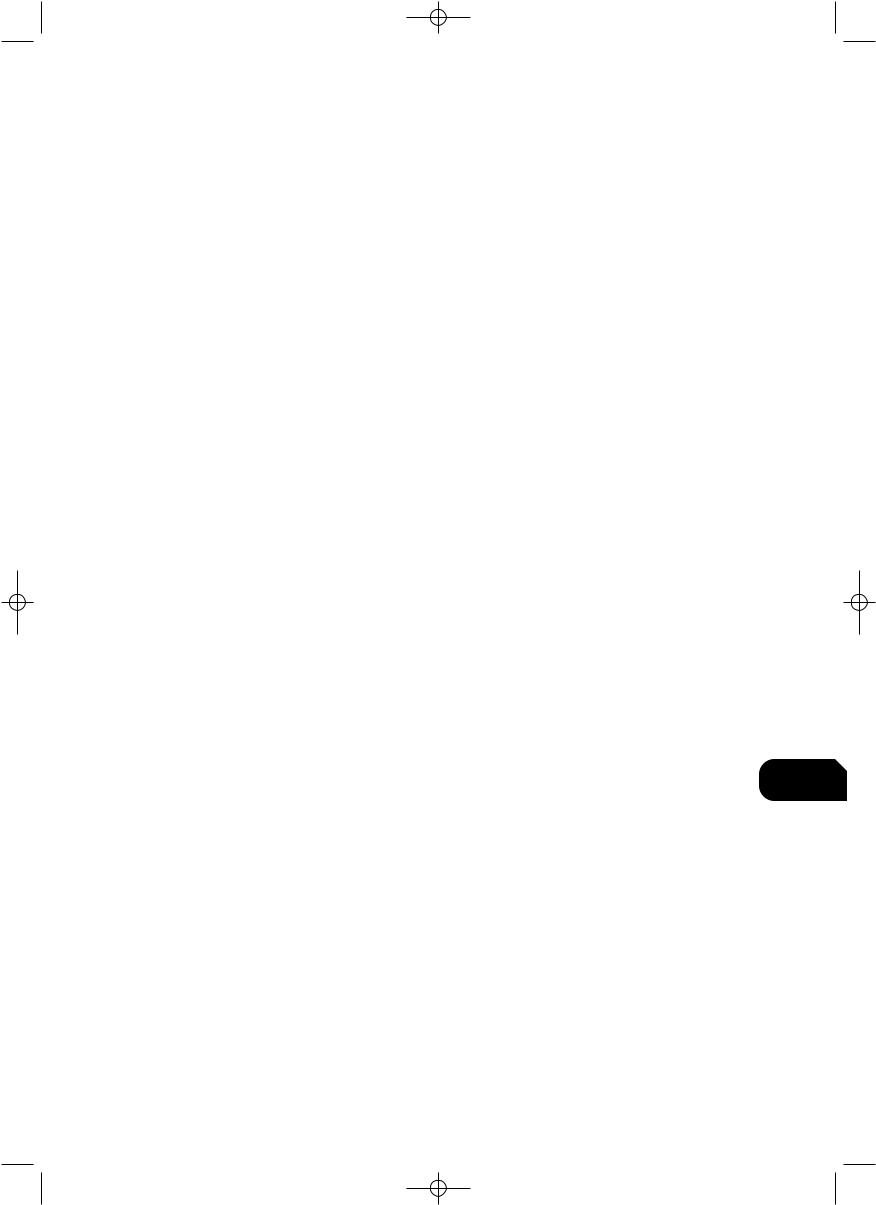
T 973manual C.qxd 8/21/2006 11:39 AM Page 9
accidentellement dans l’amplificateur, débranchez immédiatement le cordon d’alimentation secteur. Ne remettez pas l’amplificateur sous tension avant de l’avoir fait examiner par un technicien de service après vente.
L’amplificateur génère une quantité modérée de chaleur, ce qui nécessite une aération efficace. N’obstruez pas les grilles de sortie d’air sur les couvercles supérieur ou inférieur. Il est nécessaire de prévoir un dégagement d’au moins 75 mm au dessus de l’amplificateur et de 25 mm sur les côtés. Ne placez pas l’amplificateur dans un endroit fermé, comme par exemple dans une bibliothèque ou une vitrine, à moins que l’endroit ne soit très bien aéré. Veillez à ce qu’il y ait un dégagement suffisant à l’arrière de l’amplificateur pour permettre le branchement des entrées signaux et des sorties haut parleurs. S’il est nécessaire de placer l’amplificateur sur un sol moquetté, il doit impérativement être posé sur une planche ou une plaque afin d’empêcher tout enfoncement, ce qui obstruerait les ouïes d’entrée d’air sur la face inférieure. Ne placez pas l’amplificateur à un endroit où il sera exposé aux rayons du soleil pendant de longues périodes.
Cet appareil peut être posé sur n’importe quelle surface robuste et horizontale.
NOTA: Le poids de l’amplificateur doit toujours reposer sur les pieds de la face inférieure. Ne posez jamais l’amplificateur sur son panneau arrière, face parlante vers le haut, sous peine d’endommager les connecteurs d’entrée-sortie.
Le transformateur de puissance du T 973 génère un champ de bourdonnement magnétique de puissance moyenne. Les platines tourne-disque (surtout celles équipées d’une cartouche pick-up à cadre mobile) ne doivent pas être placées près de l’amplificateur. Les supports magnétiques, comme par exemple les bandes audio et vidéo ou les disquettes informatiques, ne doivent pas être stockés à proximité de l’amplificateur.
CONNEXIONS / COMMANDES SUR LA FACE ARRIÈRE
1. CORDON D’ALIMENTATION SECTEUR
Branchez le cordon d’alimentation secteur sur une prise murale proche dont la tension correspond à celle indiquée sur la face arrière de l’amplificateur. Ne branchez pas l’amplificateur sur une prise d’alimentation commutée de votre préamplificateur. L’amplificateur consomme une puissance plus importante que celle normalement fournie par ce type de prise d’alimentation.
2. ENTRÉES
Chacun des sept amplificateurs de puissance indépendants à l’intérieur du T 973 possède son propre connecteur d’entrée signal. Avant de procéder à un quelconque branchement sur l’appareil, vérifiez que l’alimentation [POWER] est coupée [OFF].
Branchez les câbles entre le préamplificateur, le décodeur de sonorisation enveloppante ou les autres sources de signaux à ces entrées. Afin d’optimiser la dissipation de la chaleur d’une chaîne de sonorisation enveloppante AV, nous vous recommandons de répartir les voies audio de la façon suivante:
Entrée 1 = Haut-parleur principal droit
Entrée 2 = Haut-parleur de sonorisation enveloppante droit Entrée 3 = Haut-parleur central
Entrée 4 = Haut-parleur de sonorisation enveloppante gauche
Entrée 5 = Haut-parleur principal gauche
Entrée 6 = Haut-parleur de sonorisation enveloppante ambioph
Entrée 7 = Haut-parleur de sonorisation enveloppante ambioph
3. COMMANDES DE NIVEAU D’ENTRÉE
L’amplificateur est équipé de commandes de niveau d’entrée séparées pour chaque voie. Avant de mettre le T 973 sous tension pour la première fois, veillez à ce que toutes les commandes de niveau soient réglées à leur position normale en butée horaire.
Dans certaines circonstances, il peut s’avérer utile d’utiliser des réglages différents pour :
•Equilibrer les niveaux d’entrée - Pour les chaînes équipées de haut parleurs dont le rendement n’est pas identique, il faut parfois réduire le niveau d’entrée de certaines entrées pour que l’équilibre entre les différentes voies soit correct.
•Augmentation de la plage de réglage du volume sonore - Nombreuses sont les chaînes stéréo dont le gain en tension est tellement important que les haut parleurs (et par conséquent les oreilles de l’auditeur) sont surchargés dès que l’on règle la commande de volume au delà de la position 11 heures ou 12 heures. Il s’en suit que la plage utile de la commande de volume sonore est limitée à sa moitié inférieure, plage dans laquelle les réglages sont imprécis et où les erreurs d’équilibrage des voies ont tendance à être plus importantes. En diminuant le réglage de toutes les commandes de niveau d’entrée, il devient possible d’augmenter le volume sonore du préamplificateur et d’utiliser la plupart de la plage de cette commande. (Suggestion : réglez les commandes de niveau d’entrée de manière à ce que les niveaux sonores maximum souhaitables se trouvent à environ 2 ou 3 heures sur la commande de volume sonore). Autre avantage : cette procédure élimine tout bruit généré par les circuits haut niveau du préamplificateur (par exemple le bourdonnement ou le sifflement qui ne disparaît pas lorsque le Volume est au minimum).
4. CONNEXIONS DES HAUT-PARLEURS
Cet amplificateur est équipé de bornes de haut-parleurs spéciales de type serre-fils. Branchez les haut parleurs avec du câble torsadé haute puissance (Calibre 16 ou plus). Les branchements peuvent être réalisés de trois façons différentes (Cf. Figure 1).
• Dénudez 10 mm de chaque fil de haut parleur. Dans chaque F conducteur, torsadez les brins fins pour les solidariser. Dévissez le
bouton, insérez le fil dénudé dans l’ouverture à la base du serrecâble puis revissez le bouton jusqu’à ce qu’il tienne solidement le fil. Vérifiez qu’aucun brin de fil ne touche le châssis ou la borne adjacente.
•Cosses plates. Dévissez le bouton, insérez la cosse plate en forme de “U” derrière la bague, puis serrez le bouton jusqu’à ce que la cosse plate soit solidement retenue.
•Equipez vos câbles de haut parleurs de fiches banane, et branchez ces fiches à l’extrémité des serre-câbles. Les bornes sont séparées d’une distance de 19 mm, ce qui leur permet d’accepter les fiches banane doubles (cette option n’est pas disponible sur les appareils dont la tension d’origine est de 230 V).
NOTA: Les haut parleurs doivent fonctionner en phase les uns avec les autres, de manière à produire une image stéréophonique correcte et, pour les basses fréquences, à travailler de façon complémentaire plutôt que de s’annuler mutuellement. Lors du branchement des
9
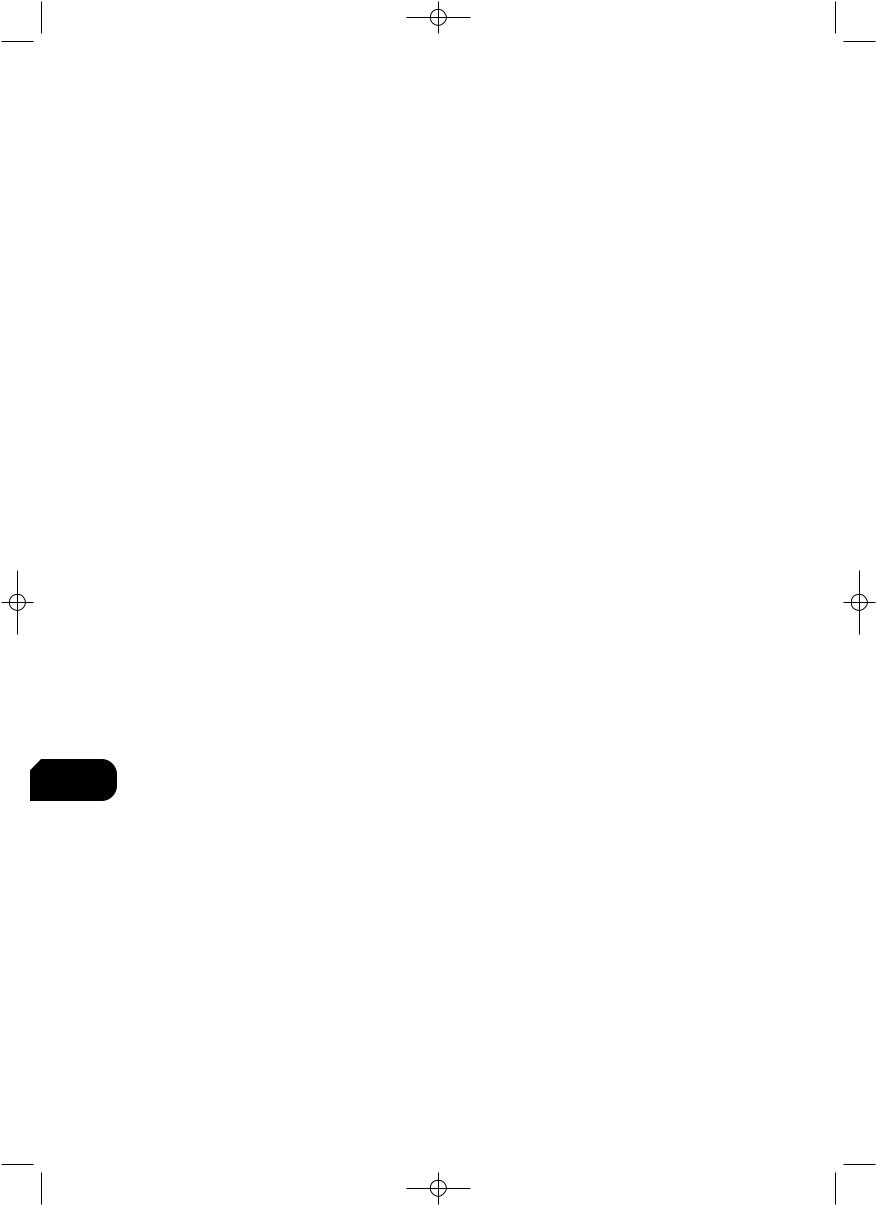
T 973manual C.qxd 8/21/2006 11:39 AM Page 10
haut parleurs, faites attention de relier la borne rouge (positive) de chaque haut parleur à la borne rouge (positive) correspondante de l’amplificateur.
5. MARCHE / ARRÊT DE LA LIAISON DE COMMANDE AUTOMATIQUE
Mettez l’interrupteur de Commande Automatique [Auto Trigger] en position Marche [On] pour activer la commande 12 V. En connectant la commande 12 V, il devient possible de télécommander le passage du T 973 du mode Veille au mode Marche, et inversement. Si cet interrupteur est en position Arrêt [Off], l’entrée de Commande 12 V [12V-trigger] est désactivée.
NOTA: Lorsque l’interrupteur de Commande Automatique [Auto Trigger] est en position Marche [ON] et que l’entrée Commande 12 V [12V-trigger] est connectée, le T 973 passera de l’état Hors Tension au mode Veille lorsque vous appuierez sur le bouton de Mise sous Tension [Power]. Pour obtenir un fonctionnement normal, veillez à ce que l’interrupteur soit en position Arrêt [OFF] ou que la prise de Commande 12 V [12V-trigger] n’est pas connectée.
6. ENTRÉE DE COMMANDE 12 V [12VTRIGGER]
Pour permettre la commutation externe entre les modes Marche et Veille, branchez la sortie de Commande 12 V [12V-Trigger] d’un élément source à ce jack d’entrée courant continu. La broche centrale est la connexion “chaude” ou “+”, alors que la gaine extérieure du jack d’entrée correspond au “-” de Commande 12 V, c’est à dire à la masse.
NOTES: La commande 12 V du T 973 fonctionnera dans une plage de 6 à 15 V CC et consomme moins de 10 mA de courant. Vérifiez les spécifications de la source de commande 12 V pour être sûr qu’elle est compatible avec l’entrée de Commande 12 V du T 973. Ne dépassez pas la tension préconisée sous peine d’endommager le T 973.
7. ECRETAGE DOUX
Lorsqu’un amplificateur est poussé au delà de sa puissance nominale, il génère normalement un phénomène “d’écrêtage dur” ou de distorsion du signal. Ce type d’écrêtage dur est non seulement désagréable, mais il peut aussi endommager les haut parleurs de la
F chaîne. Le circuit d’Ecrêtage Doux NAD limite en douceur la forme d’onde de sortie, ce qui minimise la distorsion audible et réduit la probabilité de détérioration des haut parleurs lors d’une surcharge de l’amplificateur. Nous recommandons à l’utilisateur de laisser l’interrupteur d’écrêtage doux, sur le panneau arrière du T 973, en position Marche [ON] lorsque la chaîne fonctionne à des niveaux sonores susceptibles de dépasser la puissance nominale de l’amplificateur. La LED sur la face parlante indique si le mode d’Ecrêtage Doux est actif.
8. FUSE
Près de l’implantation du câble secteur se trouve un porte-fusible. Dans le cas improbable où il serait nécessaire de remplacer le fusible, débranchez d’abord le cordon secteur de la prise murale. Débranchez ensuite tous les câbles reliés à l’amplificateur. Le fusible de rechange doit impérativement être du même type et de la même taille que le fusible d’origine.
9. CONNECTEUR DE MISE A TERRE [GROUND]
Sur le panneau arrière du T 973 se trouve une borne de mise à terre [GROUND]. Cette borne est reliée directement au logement du T973. En cas de ronflement ou de brouillage, il est recommandé de relier cette borne à une “véritable mise à terre”, comme par exemple une barre cuivrée dont 1 mètre est enfoncé dans la terre.
COMMANDES SUR LA FACE PARLANTE
1. INTERRUPTEUR DE MISE SOUS TENSION [POWER]/ VEILLE
Appuyez sur ce bouton pour mettre l’amplificateur sous tension ou hors tension. La LED de Marche [Power] située juste au dessus du bouton de Marche/Arrêt s’allume, tout comme la LED de Protection. Quelques secondes plus tard, la LED de Protection s’éteint pour indiquer que l’amplificateur est prêt à fonctionner.
Il est possible de faire commuter le T 973 entre les modes Marche et Veille grâce à l’entrée de Commande 12 V [12V-trigger] sur le panneau arrière. Pour que l’entrée de Commande 12 V puisse fonctionner, il faut d’abord mettre le T 973 sous tension à l’aide de l’interrupteur Marche/Arrêt [Power], qui doit rester en positon Marche. En agissant sur l’élément source de la commande 12 V, mettez sa sortie de Commande 12 V successivement sur Marche et sur Arrêt. L’entrée de Commande 12 V du T 973 suivra l’état de la sortie de Commande 12 V de l’élément source. Veillez à ce que l’interrupteur de Commande Auto [Auto Trigger] sur le panneau arrière soit en position Marche [ON] et à ce que l’entrée de Commande 12 V [12V-trigger] soit correctement branchée.
2. LED DE PROTECTION
La LED de Protection s’allume lors de chaque mise sous tension de l’amplificateur. Elle s’éteint après quelques secondes et l’amplificateur est prêt à fonctionner. La LED de Protection s’allume aussi lorsque l’entrée de Commande 12 V [12V-trigger] est active (et que l’interrupteur de Commande Automatique [Auto Trigger] sur le panneau arrière est en position Marche [ON]), pour indiquer l’état de Veille. Dans ce mode, la LED de Marche/Arrêt est éteinte. Cette LED s’allume aussi lorsqu’un ou plusieurs des sept amplificateurs internes bascule(nt) en mode de protection, alors que les autres amplificateurs continuent à fonctionner ; il est donc probable que vous entendrez du son même si cette LED est allumée.
Lorsque l’amplificateur est mis complètement hors tension à la suite d’un fonctionnement normal, suite à une action sur l’interrupteur de Marche/Arrêt [power], la LED de Protection s’allume puis s’éteint petit à petit sur une période de quelques secondes.
NOTA: Si la LED se protection s’allume pendant l’utilisation normale, éteignez immédiatement l’amplificateur. Vérifiez le branchement correct de tous les câbles des haut-parleurs, et qu’aucun des fils n’est endommagé, ce qui pourrait provoquer un court-circuit. Une autre cause possible est l’accumulation de chaleur à l’intérieur de l’amplificateur. Vérifiez que la ventilation autour de l’amplificateur est suffisante et qu’aucune de ses fentes de ventilation, sur le dessus et sur le dessous, n’est obstruée. Une fois qu’il aura refroidi, l’amplificateur fonctionnera à nouveau correctement.
Si la LED de Protection reste allumée en dépit des contrôles décrits ci-
10
